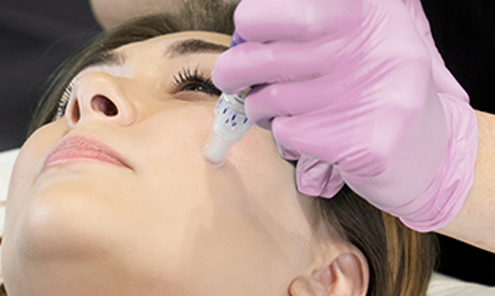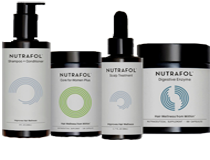The Science Behind Microneedling
Aesthetic treatments have evolved a great deal in the last decade. Harsh, ablative laser treatments with weeks of downtime are being replaced by gentler and more natural procedures that offer spectacular results. Among these groundbreaking new skincare and anti aging treatments, microneedling has emerged as a revolutionary technique for skin rejuvenation.
Microneedling is a minimally invasive procedure that has gained significant popularity with women and men of all ages who are seeking effective, non-surgical solutions for a wide variety of skin concerns. At Better U Medical Spa, located in the Tenafly area, microneedling has become a go-to treatment for those looking to improve skin texture, reduce fine lines, and achieve a more youthful appearance – affordably and with little to no downtime.
Microneedling, also known as collagen induction therapy, harnesses the body’s natural healing processes to rejuvenate the skin. In this article, we delve into the science behind microneedling, and it becomes clear why this procedure has become a cornerstone of modern aesthetic medicine.
Understanding the Basics of Microneedling
At its core, microneedling involves the use of fine needles to create microscopic punctures in the skin’s surface. These tiny injuries, while imperceptible to the naked eye, trigger the body’s wound healing response. Dr. Gor and the skilled practitioners at Better U Medical Spa in the Tenafly area use advanced microneedling devices to precisely control the depth and pattern of these micro-injuries, tailoring the treatment to each patient’s unique skin needs.
As we age, the natural production of collagen and elastin decreases, leading to the formation of wrinkles and loss of skin tone. The science behind microneedling lies in its ability to stimulate collagen and elastin production. These two proteins are essential for maintaining skin elasticity, firmness, and overall youthful appearance. Microneedling effectively jumpstarts the production of these vital proteins, leading to improved skin texture and tone – and a more radiant complexion.
The Cellular Response to Microneedling
When microneedling is performed, it initiates the cellular events that contribute to skin rejuvenation. The controlled micro-injuries created during the procedure trigger the release of growth factors and cytokines, which play crucial roles in tissue repair and regeneration. These signaling molecules stimulate the production and migration of fibroblasts, the cells that are responsible for producing collagen and other extracellular matrix components.
Research published in the Journal of Clinical and Aesthetic Dermatology has demonstrated that microneedling can increase collagen and elastin deposition in the dermis (lower layer of the skin), leading to significant improvements in skin quality [1]. For patients at Better U Medical Spa in the Tenafly, NJ area, this translates to noticeable reductions in fine lines, wrinkles, minimizing of acne scars, and overall improvements in skin texture and tone.
Radiofrequency Microneedling with Morpheus 8
While traditional microneedling has proven to be highly effective on its own, advanced techniques have further enhanced its capabilities. At Better U Medical Spa in the Tenafly, NJ area, patients have access to cutting-edge microneedling treatments that combine the benefits of collagen induction therapy with other innovative technologies for even more spectacular results.
One such advancement is the incorporation of radiofrequency energy into the microneedling process. This technique, often referred to as RF microneedling, takes the benefits of traditional microneedling to the next level by delivering thermal energy deep into the skin layers. The combination of mechanical micro-injuries and heat stimulation results in more dramatic improvements in skin tightening and rejuvenation.
Morpheus 8 is a state-of-the-art RF microneedling device, known for its ability to provide comprehensive skin rejuvenation. This advanced system combines microneedling with fractionated radiofrequency energy to remodel and contour the face and body. At Better U Medical Spa, Morpheus 8 treatments are tailored to address a wide range of concerns, from skin laxity to deep wrinkles.
The science behind Morpheus 8 lies in its ability to deliver RF energy to precise depths in the skin. The adjustable needle depth allows Dr. Gor to target specific layers of tissue, from the superficial epidermis to the deeper subdermal layers. This precision enables the treatment of various skin concerns simultaneously, resulting in more comprehensive rejuvenation.
A study published in the Journal of Cosmetic Dermatology found that RF microneedling treatments like Morpheus 8 led to significant improvements in skin laxity, wrinkle severity, and overall skin quality [2]. For patients seeking a more dramatic transformation, Morpheus 8 offers a non-surgical alternative to more invasive procedures.
Microneedling with PRP: The Vampire Facial
Another innovative approach to microneedling that has gained popularity with celebrities in Hollywood and everyday people in Tenafly, NJ, is the combination of the procedure with platelet-rich plasma (PRP). This procedure is commonly known as the “Vampire Facial.” This treatment, offered at Better U Medical Spa in the Tenafly area, harnesses the regenerative properties of the patient’s own blood to enhance the skin rejuvenation process.
The science behind PRP microneedling involves isolating the platelet-rich plasma from a small sample of the patient’s blood. This concentrated solution of platelets and growth factors is then applied to the skin during or immediately after the microneedling procedure. The micro-channels created by the needles allow for deep penetration of the PRP, delivering its regenerative components directly to the areas where they’re needed most.
Research published in the Journal of Cutaneous and Aesthetic Surgery has shown that combining microneedling with PRP leads to better outcomes in resurfacing skin compared to microneedling alone [3]. This means a more comprehensive improvements in skin texture, tone, and overall appearance than microneedling by itself.
Long-Term Benefits of Microneedling
One of the most compelling aspects of microneedling for Tenafly, NJ residents is its ability to provide long-lasting results. Unlike some topical treatments that offer only temporary improvements, the collagen and elastin stimulation induced by microneedling leads to sustained skin rejuvenation. The increased production of these structural proteins continues for weeks to months after the treatment, resulting in progressive improvements in skin quality that are long lasting.
Unlike dermal fillers or Botox that are absorbed or wear off, microneedling leads to continued enhancements in the skin’s appearance for following their microneedling sessions. This gradual improvement aligns with the natural process of collagen remodeling, which can take several weeks to fully manifest.
The versatility of microneedling allows for highly customized treatments tailored to individual skin concerns. At Better U Medical Spa in the Tenafly, NJ area, Dr. Gor work closely with each patient to develop a personalized treatment plan. This may involve adjusting needle depths, combining microneedling with other therapies like PRP, or incorporating specialized serums to address specific skin issues.
For some patients a series of traditional microneedling sessions may be recommended to achieve optimal results. The ability to customize the approach ensures that each patient receives the most effective treatment for their unique skin needs.
Safety and Efficacy of Microneedling
The safety profile of microneedling has contributed significantly to its popularity. Because microneedling is 100% natural, there is little to no risk of side effects. When performed in a doctor’s office by trained professionals, such as those at Better U Medical Spa, microneedling carries minimal risk of adverse effects.
Additionally, the procedure is suitable for most skin types and colors, and can be safely performed on almost any area of the face and body.
Numerous clinical studies have confirmed the effectiveness and safety of microneedling in treating a range of skin concerns. A comprehensive review published in the Journal of Plastic, Reconstructive & Aesthetic Surgery found that microneedling was effective in improving acne scars, skin texture, and overall skin quality, without complications and with high patient satisfaction rates [4].
Microneedling | Tenafly, NJ Area
The science behind microneedling makes it a powerful and versatile treatment that can address a wide range of skin concerns. From traditional collagen induction therapy to advanced techniques like RF microneedling with Morpheus 8 and PRP-enhanced Vampire Facial treatments, microneedling is versatile and highly effective.
If you’re in the Tenafly, NJ area, and you are looking to rejuvenate your skin through the power of science-backed treatments, microneedling could be the solution you’ve been seeking. Whether you’re interested in addressing fine lines, improving skin texture, or achieving overall skin rejuvenation, the experienced team at Better U Medical Spa is ready to guide you through your options.
Don’t wait to discover the transformative effects of microneedling – schedule a consultation today and take the first step towards healthier, more youthful and radiant skin!
Tenafly, NJ Area Microneedling: 201-541-6858
.
SOURCES:
[1] Aust, M. C., et al. (2008). Percutaneous collagen induction therapy: an alternative treatment for scars, wrinkles, and skin laxity. Plastic and Reconstructive Surgery, 121(4), 1421-1429.
[2] Seo, K. Y., et al. (2013). Skin rejuvenation by microneedle fractional radiofrequency and a human stem cell conditioned medium in Asian skin: a randomized controlled investigator blinded split-face study. Journal of Cosmetic and Laser Therapy, 15(1), 25-33.
[3] Chawla, S. (2014). Split face comparative study of microneedling with PRP versus microneedling with vitamin C in treating atrophic post acne scars. Journal of Cutaneous and Aesthetic Surgery, 7(4), 209-212.
[4] Ramaut, L., et al. (2017). Microneedling: Where do we stand now? A systematic review of the literature. Journal of Plastic, Reconstructive & Aesthetic Surgery, 70(6), 805-814.






